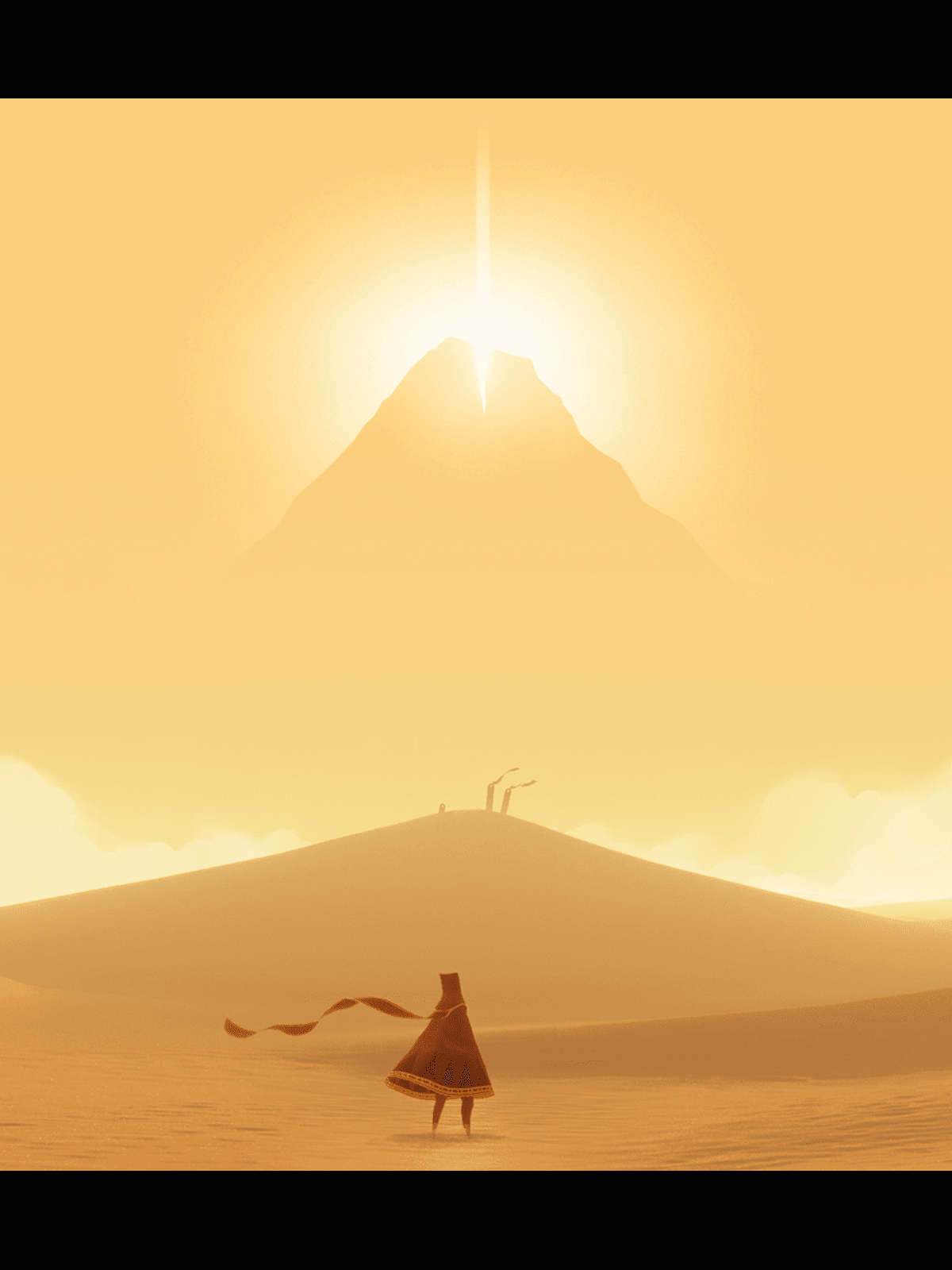For this week’s critical play, I played Journey, a walking simulator for those ages 12 and above developed by Thatgamecompany. Because the game is relatively short, I played through its entirety on my own to fully grasp how the story plays out as our main character treks through ancient ruins and to the mountain’s peak. As a game where walking and short bursts of flight are the only actions available to the player, Journey uses the natural limitations of walking to guide the player through its embedded narrative at a purposeful pace while using the character’s walk to communicate tone, emotion, and story beats.
Pacing
Walking is naturally slow, and as the main character moves through Journey’s narrative, the player is forced to navigate the ruins and deserts of the game at a pace dictated by the character’s speed, maximizing the extent to which a player experiences each chapter. In my journey through the ruins, I started slowly as my robed figure took gentle steps through the desert plains. The journey from this spot o n the left to the mountain took well over 10 minutes. Since I could only walk, those 10 minutes were consumed by exploration; my inability to speed through the empty desert made every discovery in the form of ruins or rubble all the more engaging. By incorporating this limitation on how quickly the player can navigate through space, the player’s appreciation for novel discoveries is enhanced. This slow movement between places of interest helps the game build narrative tension and anticipation as the players slowly move towards a looming structure in the distance with the next waypoint and fulfills the psychogenic need for achievement when the player finally reaches it. Journey’s two main types of fun, sensation (evidenced by the stunning visuals, beautiful music, and haptic feedback on an iPhone) and exploration (made clear by the premise of the game: a robed figure exploring ancient ruins), are thus further amplified by the walking mechanic and its slow pace. As the player spends more time walking, they can experience more of the game’s artistic style, and exploration becomes more rewarding.
n the left to the mountain took well over 10 minutes. Since I could only walk, those 10 minutes were consumed by exploration; my inability to speed through the empty desert made every discovery in the form of ruins or rubble all the more engaging. By incorporating this limitation on how quickly the player can navigate through space, the player’s appreciation for novel discoveries is enhanced. This slow movement between places of interest helps the game build narrative tension and anticipation as the players slowly move towards a looming structure in the distance with the next waypoint and fulfills the psychogenic need for achievement when the player finally reaches it. Journey’s two main types of fun, sensation (evidenced by the stunning visuals, beautiful music, and haptic feedback on an iPhone) and exploration (made clear by the premise of the game: a robed figure exploring ancient ruins), are thus further amplified by the walking mechanic and its slow pace. As the player spends more time walking, they can experience more of the game’s artistic style, and exploration becomes more rewarding.
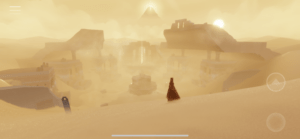
Limiting the player’s movement to walking and chirping is evidently a choice to prioritize player immersion as they move from ruin to ruin. Still, this space between locations can create frustration and boredom when a player is tired of slowly moving toward an interesting location. In my playthrough, I found myself pressing the flight button simply to light up my scarf or chirping just to make the sand around me move while I walked toward my goal. These behaviors came from an attempt to fill empty spaces like the one to the right with my own actions, but walking alone was too limiting to accomplish this.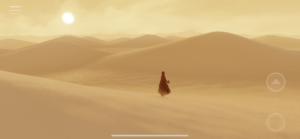 The solution would be to bring the locations closer together or speed up the character. However, doing this would negatively impact the game’s purposeful pace and tension, harming the exploration and artistic aesthetic to please more impatient players like myself. The game could alternatively alleviate this lack of activity (at least for solo players) by introducing smaller discoveries along the path, like smaller structures or variations in terrain in a way similar to Skyrim, which places unmarked points of interest, like two skeletons hugging or an altar on the road between important locations. This would satiate the need for information in an embedded narrative without distracting the player from the overarching goal or minimizing discoveries.
The solution would be to bring the locations closer together or speed up the character. However, doing this would negatively impact the game’s purposeful pace and tension, harming the exploration and artistic aesthetic to please more impatient players like myself. The game could alternatively alleviate this lack of activity (at least for solo players) by introducing smaller discoveries along the path, like smaller structures or variations in terrain in a way similar to Skyrim, which places unmarked points of interest, like two skeletons hugging or an altar on the road between important locations. This would satiate the need for information in an embedded narrative without distracting the player from the overarching goal or minimizing discoveries.
Tone and Emotion
Narratively, the character’s walk fulfills a second purpose: serving as a tool to communicate the tone and emotion of the story. This is exemplified in the final act of climbing the snowy mountain, where my character fought against the wind, an upward slope, and aggressive snake monsters. As my character reached a point of great conflict, his walk transformed from the gentle steps of the desert, the energetic sliding down the slopes, or the elated flight through the towers to a slow, difficult walk where it seemed like with every step came conflict. These changes in walking style work alongside the music to elicit emotions from the player. 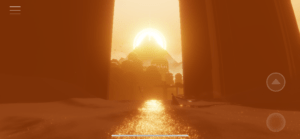 When the robed explorer is sliding or flying, the conveyed emotion is joy or freedom, like the slide down the tunnel at sunset to the left. Alternatively, the agonizing trek through the cold, where one misstep could reset hard-earned progress, evokes adversity, conflict, and pain in the player. These changes primarily serve a narrative purpose as the player becomes attuned to the emotional highs and lows of the story the game designer is telling. Even playing muted and greyscale, the narrative stage the protagonist is in is evident through their movement. This contributes to the narrative aesthetic and helps the player connect to their avatar’s challenges, even if there isn’t an increase in difficulty, making their ultimate achievement much more satisfying.
When the robed explorer is sliding or flying, the conveyed emotion is joy or freedom, like the slide down the tunnel at sunset to the left. Alternatively, the agonizing trek through the cold, where one misstep could reset hard-earned progress, evokes adversity, conflict, and pain in the player. These changes primarily serve a narrative purpose as the player becomes attuned to the emotional highs and lows of the story the game designer is telling. Even playing muted and greyscale, the narrative stage the protagonist is in is evident through their movement. This contributes to the narrative aesthetic and helps the player connect to their avatar’s challenges, even if there isn’t an increase in difficulty, making their ultimate achievement much more satisfying.
However, this evolution of walking style and difficulty arrives at an unsatisfying climax and falling action since the character’s most intense moment, and thus most arduous walk, is not rewarded with freedom of movement. Once the character has overcome the struggle of the mountain, the player should be rewarded with a sense of completion and finality in the form of liberation. In Control, a game that follows a woman’s journey through a supernatural building, the story climaxes in a battle that requires using each of her collected abilities, giving the player a sense of power and achievement as everything they’ve collected comes into play. In contrast, Journey presents the story’s climax, reaching the mountain’s peak, as the end of a struggle, rewarding the player with a cut scene where the robed figure can fly freely.
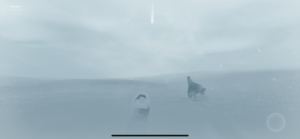
Offering the player this level of control and freedom with a playable chapter would have communicated the elation, liberation, and peace that came with the character’s ascension in a manner consistent with the notion that the character’s movement matches the emotional beats throughout the rest of the game.


